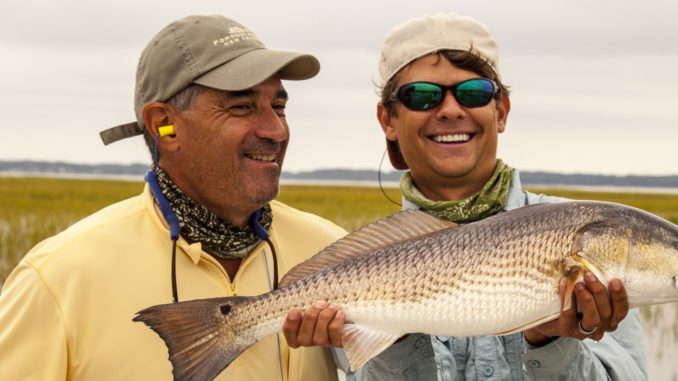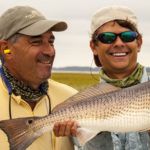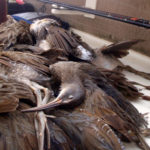
Fall’s high tides will put reds, rails in your sights
For many sportsman, hunting and fishing are passions worth pursuing, and often, both are good at the same time. Alternating day or weekend trips between hunting and fishing is a routine for these sportsman. Some even fish and hunt the same morning or afternoon.
In the fall, an almost-magical opportunity arises for hook-and-bullet addicts: the season for marsh hens opens, and the inshore marshes where the birds reside are areas where redfish and trout also like to hang out. Shooting a couple of rails, putting down the shotgun down and picking up a rod and catching a redfish is not unheard of. Slaying trout and reds on an incoming tide before moving into the flooded grass and then concentrating on birds is common.
“There are times when shooting that you’ll see a tailing red pop up, lay down the gun, pick up the rod and stick a tailing redfish; but mostly it’s fishing, then hunting, or vise-versa,” said Capt. Owen Plair of Beaufort’s Bay Street Outfitters.
Fall is indisputably the best time of year for inshore fishing. Putting the feed on in preparation for winter, trout and reds behave aggressively. Live shrimp under rattling corks are particularly effective; everything swimming likes to eat shrimp, especially reds and trout, and with trout numbers rebounding nicely this year, fishing action is almost non-stop. Creek mouths, oyster beds and grass lines just off the bank are all great areas to target. The more of those features within the same area, the better the chances are for big numbers of fish.
For reds tailing in the grass once the tide starts to get high, crab chunks, crab imitations like Gulp! and crab flies work well. Basically, the birds are there, and the fish are feeding.
“It is always exciting to come into a new season fish wise, like when the cobia show up in the spring,” said Capt. Tuck Scott, also of Bay Street Outfitters, “but this is the ultimate seasonal change when you get to pull out two outdoor tools and go hunting for fish and birds.”
South Carolina’s coast is blessed with an abundance of rails, but many people do not realize just how many are out there because they live deep in the marsh and rarely show themselves. But when the tides are big, it pushes them out into the open and into the reach of hunters.
Any marsh can hold rails, but the best ones are found with the ears, not the eyes. Marsh hens make a crackling call, so the more “bird noise” coming from a marsh, the more birds to hunt that marsh floods.
“When out fishing, it’s a good idea to have an open ear for crackling birds, and then go back to that area when it is time to hunt,” Scott said.
Not all high tides are the same, and for hunting rails, it takes one much bigger than average. The exact height depends on the area targeted, and according to Scott, “Tide heights need to be in the upper 15 percent of the heights for the given area you fish and hunt.”
Plair uses the Savannah River entrance reference station as a general guide.
“You need a tide higher than 8.5 so it floods the marsh enough to push the birds out into your vision, but a west wind can hold out the tide, so be careful when setting up your trip,” he said.
Exploring a marsh is best done by one person poling a boat through the flooded grass and another on the bow and at the ready. Rails congregate on any exposed grass or around creek mouths, but they are particularly fond of floating debris, including big clumps of dead grass.
Exploding into the air when a boat draws near to them, hunters get an experience on the water not unlike the experience of flushing a covey of quail on land. But marsh hens are not as fast as other birds that are often wing-shot, and hunters have to adjust. Fortunately, the visual of shot hitting the water makes gauging needed adjustments much easier.
Big guns aren’t necessary for rails.
“I think the correct gauge for these birds is a 20-gauge,” Scott said. “An over-and- under or side-by-side makes for the best sporting-bird shooting; steel, bismuth, or tungsten shot is required for these birds so no lead goes into the marsh.”
Both Scott and Plair use 7-foot medium to medium-light spinning rods and 7- to 9-weight fly rods for reds and trout.
Casting and blasting on the same trip is the ultimate for sportsman who can’t get enough hunting and fishing. It’s as close to having your cake and eating it, too.






Be the first to comment